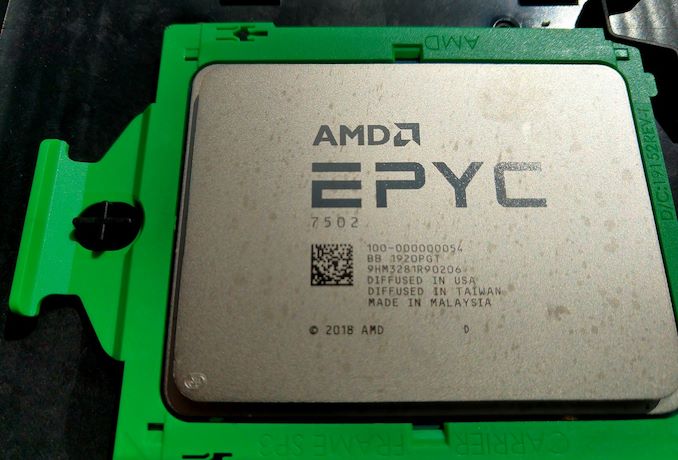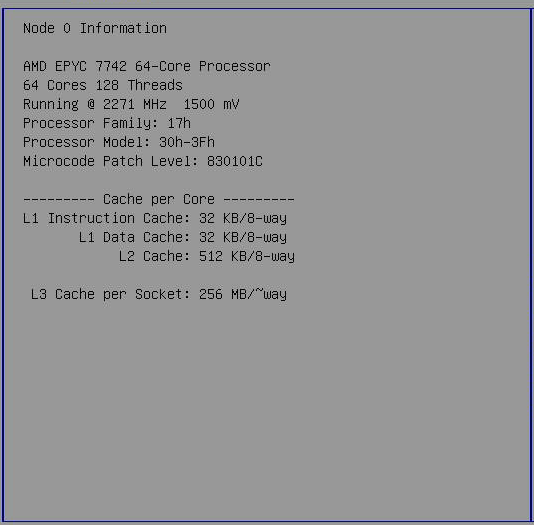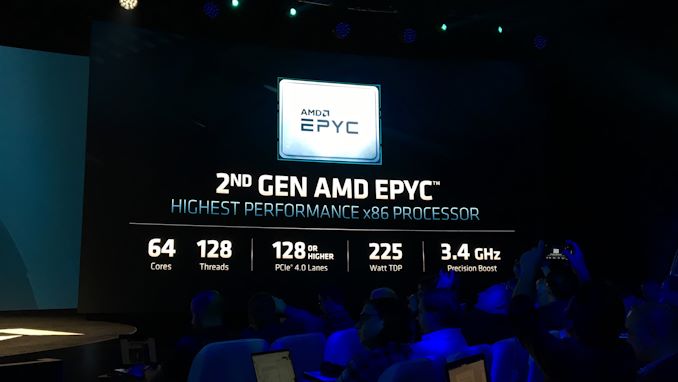AMD Rome Second Generation EPYC Review: 2x 64-core Benchmarked
by Johan De Gelas on August 7, 2019 7:00 PM EST
If you examine the CPU industry and ask where the big money is, you have to look at the server and datacenter market. Ever since the Opteron days, AMD's market share has been rounded to zero percent, and with its first generation of EPYC processors using its new Zen microarchitecture, that number skipped up a small handful of points, but everyone has been waiting with bated breath for the second swing at the ball. AMD's Rome platform solves the concerns that first gen Naples had, plus this CPU family is designed to do many things: a new CPU microarchitecture on 7nm, offer up to 64 cores, offer 128 lanes of PCIe 4.0, offer 8 memory channels, and offer a unified memory architecture based on chiplets. Today marks the launch of Rome, and we have some of our own data to share on its performance.
Review edited by Dr. Ian Cutress
First Boot
Sixty-four cores. Each core with an improved Zen 2 core, offering ~15% better IPC performance than Naples (as tested in our consumer CPU review), and doubled AVX2/FP performance. The chip has a total of 256 MB of L3 cache, and 128 PCIe 4.0 lanes. AMD's second generation EPYC, in this case the EPYC 7742, is a behemoth.
Boot to BIOS, check the node information.
[Note: That 1500 mV reading in the screenshot is the same reading we see on consumer Ryzen platforms; it seems to be the non-DVFS voltage as listed in the firmware, but isn't actually observed]
It is clear that the raw specifications of our new Rome CPU is some of the most impressive on the market. The question then goes to whether or not this is the the new fastest server chip on the market - a claim that AMD is putting all its weight behind. If this is the new fastest CPU on the market, the question then becomes 'by how much?', and 'how much does it cost?'.
I have been covering server CPUs since the launch of the Opteron in 2003, but this is nothing like I have seen before: a competitive core and twice as much of them on a chip than what the competition (Intel, Cavium, even IBM) can offer. To quote AMD's SVP of its Enterprise division, Forrest Norrod:
"We designed this part to compete with Ice Lake, expecting to make some headway on single threaded performance. We did not expect to be facing re-warmed Skylake instead. This is going to be one of the highlights of our careers"
Self-confidence is at all times high at AMD, and on paper it would appear to be warranted. The new Rome server CPUs have improved core IPC, a doubling of the core count at the high end, and it is using a new manufacturing process (7 nm) technology in one swoop. Typically we see a server company do one of those things at a time, not all three. It is indeed a big risk to take, and the potential to be exciting if everything falls into place.
To put this into perspective: promising up to 2x FP performance, 2x cores, and a new process technology would have sounded so odd a few years ago. At the tail end of the Opteron days, just 4-5 years ago, Intel's best CPUs were up to three times faster. At the time, there was little to no reason whatsoever to buy a server with AMD Opterons. Two years ago, EPYC got AMD back into the server market, but although the performance per dollar ratio was a lot better than Intel's, it was not a complete victory. Not only was AMD was still trailing in database performance and AVX/FP performance, but partners and OEMs were also reluctant to partner with the company without a proven product.
So now that AMD has proven its worth with Naples, and AMD promising more than double the deployed designs of Rome with a very quick ramp to customers, we have to compare the old to the new. For the launch of the new hardware, AMD provided us with a dual EPYC 7742 system from Quanta, featuring two 64-core CPUs.












180 Comments
View All Comments
nathanddrews - Wednesday, August 7, 2019 - link
Binned for OC? We'll find out soon enough!DigitalFreak - Thursday, August 8, 2019 - link
At this point it looks like all TR will get your is "official" ECC support and more PCIe lanes. Maybe cheaper motherboards than EPYC.willis936 - Thursday, August 8, 2019 - link
Half the memory lanes (this is a big one), half the pcie lanes, max of 1 socket per mobo. Those are important features for datacenter customers and their absence from threadripper makes threadripper less desirable than epyc in the datacenter.rocky12345 - Thursday, August 8, 2019 - link
Yes but Threadripper is made for high end desktops for video editing etc etc and some gaming. I do not see the big data center guys going after TR all that much. Yes you may see some of the TR go there but that is not what TR is made for that is why we have EPYC & XEON CPU's.I do have to agree though where some said where does TR fit in price wise since we are going to have a 16/32 main stream desktop CPU shortly from AMD. I do also think this time around the 32/64 3990 TR will be 10x better than the older 2990 TR just from the memory controller not being in each CPU complex and in the 2990x because of bandwidth and latency from the memory performance really suffered when all cores were being used. On the 3990x (or whatever it will be called) this should not be an issue. If AMD is smart they will not release a 64/128 3000 series TR since it would have to be priced to far out of reach for even the most techy guy with money and the only ones that would have them would be review sites and YT reviewers and that would be only because them got them sent for free for reviews. 32/64 and the better memory performance as a whole for the new chips would be more than enough to make the 32/64 TR 3990x an instant success. Just my opinion of coarse and AMD will probably do something stupid and release a higher core count TR series CPU that next to no one will be able to afford just to be able to say hey we got the best high end CPU on the planet but to bad no one is gonna buy them because the price is to high but we have the best so who cares.
rocky12345 - Thursday, August 8, 2019 - link
Oops dammit forgot to make paragraph's did not mean to have it all bunched up like that.Mark Rose - Friday, August 9, 2019 - link
Why wouldn't they release a 64 core Threadripper? Assuming they double the price of the 32 core, it would be $3400. That's affordable to a lot of people working in tech, and should be affordable to just about any business that has employees waiting on their 32 core Threadripper. AMD would sell a ton.That being said, I wouldn't personally buy one as I don't have a need. I'd be more likely buy a 16 core 3000 series Threadripper myself.
Manch - Friday, August 9, 2019 - link
Higher Clockssor - Wednesday, August 7, 2019 - link
It will be a feature/packaging thing. The motherboards would be TR4 and feature enthusiast features, overclocked memory, etc, not highly reliable server oriented boards. The processors themselves might be fairly comparable to their EPYC counterparts, as some Xeons were occasionally comparable to their desktop ones.close - Thursday, August 8, 2019 - link
TR was supposed to be a stopgap measure until the consume Ryzen range stretched high enough and the server EPYC range stretched low enough. I guess there is a place for further differentiation especially in terms of the platform (motherboard) used, where you have server like CPU on a more consumer like MB to create basically a workstation. Maybe OC will also fit in here.Death666Angel - Friday, August 9, 2019 - link
"TR was supposed to be a stopgap measure" where can I see AMD stating that? Considering Intel has fared pretty well with the consumer/HEDT/server differentiation, I don't think AMD needs to axe TR. I don't see them giving us EPYC with OC functions and 8 memory channles seems overkill for 16 or 32 desktop cores. I also haven't seen a statement to the effect you claim, so I highly doubt it at the moment.